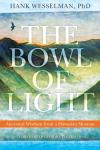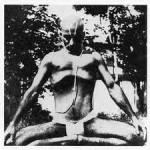Cultures throughout history have had some sort of cosmology; that is, a story or model, or belief system that defines the origins, structures and functioning of reality as experienced by that culture. The modern era’s cosmology is a quirky cultural stew of scientific rationalism, religious dogma, and enlightened spiritual insight. My vote is for an enlightened spiritual insight which arises from an ongoing, direct and intimate contact with the world as it arises moment to moment. The question here becomes what do we mean by “the world as it arises?” The shamans have a very interesting view on ‘the world’, feeling all of creation is spiritual, and that much of the world is unseen to the human eye.
Reality: An Overview
From a shamanic perspective, reality has two fundamental expressions: the seen, and the unseen. The seen is what the average human would recognize as the physical world. It  includes the sky, with clouds, stars and planets, mountains and the rest of the continents, oceans, rivers, lakes and streams, weather, and living beings of all sorts, etc, etc. All of these are experienced through the five senses and we are in constant relationship to this world in our daily activities.
includes the sky, with clouds, stars and planets, mountains and the rest of the continents, oceans, rivers, lakes and streams, weather, and living beings of all sorts, etc, etc. All of these are experienced through the five senses and we are in constant relationship to this world in our daily activities.
The unseen can also be called the dream or spirit world and and has two primary levels, the lower and upper. The lower realms include the spirits of the earth, including plant and animal spirits as well as spirits associated with rocks, rivers, weather etc. The shamanic animist reality sees all creation is being imbued with a spiritual as well as a physical expression. (Thomas Berry’s ‘Principle 3’ acknowledges these two levels.) The lower  realm, or underworld is often the destination of the dead, where human souls go in the afterlife. There are many fascinating tales and teachings about what happens to souls when they get there.
realm, or underworld is often the destination of the dead, where human souls go in the afterlife. There are many fascinating tales and teachings about what happens to souls when they get there.
The upper realms include gods, angels, devas, celestial beings, saints, ascended masters, and spiritual guides. In most cases, heaven is the highest reward, and place of eternal beauty, health and happiness and reserved for those departed souls who have passed strict qualification tests, either on the earthly plane or in the underworld. These tests vary across cultures, but they all weed out the unworthy.
This three part reality is almost universal: The heavenly realms, the earth where the action or karma of our lives take place, and the underworld, and the nature of these realms varies tremendously from culture to culture. The modern Western world is currently dominated by the patriarchal monotheistic religions who were terrified of the power of the shamans and thus redefined the lower realms as hell and murdered nearly 100,000 women through the middle ages.
The Shamanic Journey
The modern shaman uses ‘technology’ to enter ‘altered’ states of consciousness, travel to the lower and upper realms, acquire help and helpers in the form of spirit helpers or teachers, and information, to help bring healing to the middle realm of action, in the body, in culture and throughout the planet. The entry point of the journey is through the body, or body soul, aka physical soul, where perception takes place, and the ‘technology’ is to use  a drum or rattle to rhythm entrain the brain waves to fire at the Theta or 3 – 8 HZ. “Theta brainwaves occur most often in sleep but are also dominant in the deep meditation. It acts as our gateway to learning and memory. In theta, our senses are withdrawn from the external world and focused on signals originating from within. It is that twilight state which we normally only experience fleetingly as we wake or drift off to sleep. In theta we are in a dream; vivid imagery, intuition and information beyond our normal conscious awareness. It’s where we hold our ‘stuff’, our fears, troubled history, and nightmares.” (from www.brainworksneurotherapy.com). The drumming or rattling have to be accurate and consistent to sustain theta for 20 minutes or so. We will go further into some of the protocols and process of the journey in the future.
a drum or rattle to rhythm entrain the brain waves to fire at the Theta or 3 – 8 HZ. “Theta brainwaves occur most often in sleep but are also dominant in the deep meditation. It acts as our gateway to learning and memory. In theta, our senses are withdrawn from the external world and focused on signals originating from within. It is that twilight state which we normally only experience fleetingly as we wake or drift off to sleep. In theta we are in a dream; vivid imagery, intuition and information beyond our normal conscious awareness. It’s where we hold our ‘stuff’, our fears, troubled history, and nightmares.” (from www.brainworksneurotherapy.com). The drumming or rattling have to be accurate and consistent to sustain theta for 20 minutes or so. We will go further into some of the protocols and process of the journey in the future.
Our Practice
 In the last post, we began the process of differentiating the felt sense and movement possibilities related to the lower six chakras. Today we will go a little further with this exploration. Imagine a ladder; two parallel lines linked by six horizontal lines. Imagine a circle or sphere in the center of each rung, and these will represent the chakras. Now, lying down in savasana, find the chakras and the two parallel lines running down the right and left sides of your body. Visualize and feel these two lines passing through key places aside the different chakras: inner ears, two sides of the jaws, two lungs, two kidney, two pelvic bones, two legs/feet. these are just a few suggestions. Find what awakens in your own perceptual field.
In the last post, we began the process of differentiating the felt sense and movement possibilities related to the lower six chakras. Today we will go a little further with this exploration. Imagine a ladder; two parallel lines linked by six horizontal lines. Imagine a circle or sphere in the center of each rung, and these will represent the chakras. Now, lying down in savasana, find the chakras and the two parallel lines running down the right and left sides of your body. Visualize and feel these two lines passing through key places aside the different chakras: inner ears, two sides of the jaws, two lungs, two kidney, two pelvic bones, two legs/feet. these are just a few suggestions. Find what awakens in your own perceptual field.
Now imagine the space between the chakras becoming like a frisbee and let the energy spiral back and forth, ascending and descending around each of the chakras.you may begin to notice something that looks like this. Enjoy the ride. This is the ‘fishbody’ we have been working with for many years now. Smooth out the spaces. You are liable to find places on the sides of one or more chakras where the energy is sticky, or just plain stuck. In that moment, the habit is to ‘contract’ something to force the issue. Inhibit this urge. Contraction vrtti nirodha. Relax. Use imagination and visualization to help open channels.
Enjoy the ride. This is the ‘fishbody’ we have been working with for many years now. Smooth out the spaces. You are liable to find places on the sides of one or more chakras where the energy is sticky, or just plain stuck. In that moment, the habit is to ‘contract’ something to force the issue. Inhibit this urge. Contraction vrtti nirodha. Relax. Use imagination and visualization to help open channels.
Now return to the ladder image and find the points where the rungs intersect the vertical. Imagine all twelve points breathing together and feel. Imagine the heart beating simultaneously in all twelve points and feel what arises. This may take some practice and patience. Now take this into your asana practice and discover these points and energetic patterns anew. Let them dance you, reshape you, awaken you from deep within. Now go out into nature and do the same. Feel nature dancing with you. Be open to surprise, awe and wonder.
 Further Reading: “A Bowl of Light” by Hank Wesselman, and all material at sharedwisdom.com.
Further Reading: “A Bowl of Light” by Hank Wesselman, and all material at sharedwisdom.com.
(It was an amazing weekend!)







